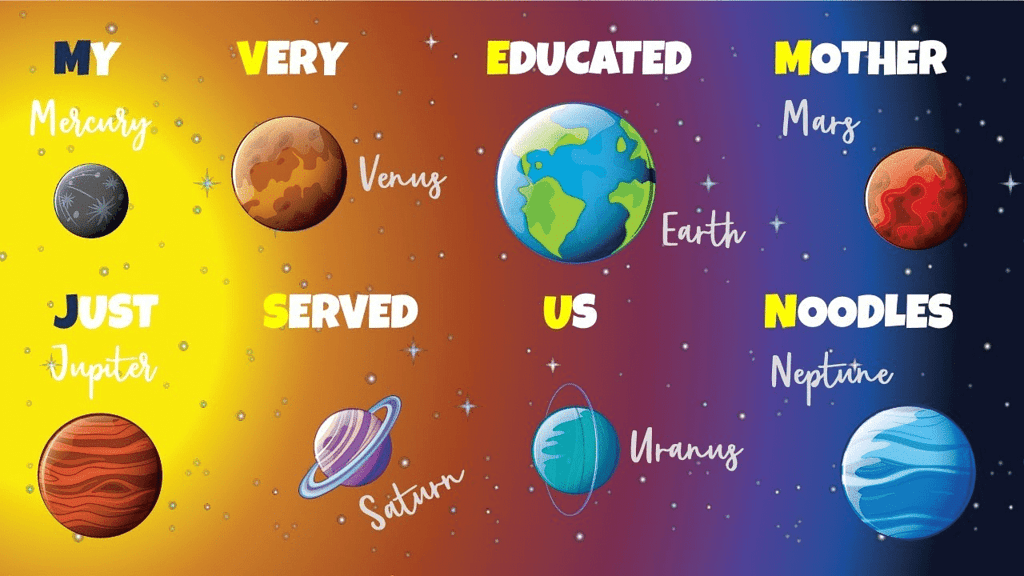The Solar System Class 4 Notes Science
| Table of contents |

|
| What is a Solar System? |

|
| The Planets |

|
| Movements of the Earth |

|
| Effects of the Earth’s Movements |

|
| (a) Day and Night |

|
| (b) The Seasons |

|
| (c) The Poles |

|
| (d) The Equator |

|
You already know that there are eight planets in the solar system. A planet is a big round ball like object that does not give out its own heat and light. It moves around a star.
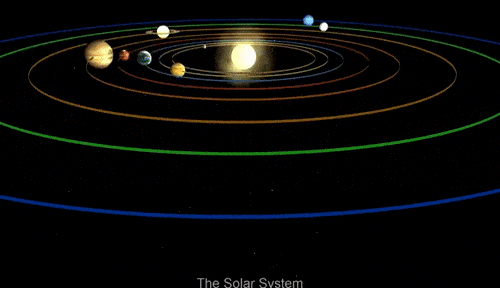
The eight planets in the solar system move around the Sun. In order of increasing distances from the Sun, these are—Mercury, Venus, Earth, Mars, Jupiter, Saturn, Uranus and Neptune.
Six of these planets have smaller objects that move around them. An object that moves around a planet is called a moon.
- The Earth has one Moon.
- Mars has two.
- Saturn has the largest number of moons – 146 !
- Mercury and Venus, the planets closest to the Sun, do not have any moons.
What is a Solar System?
The Sun, and the objects that move around it, such as the planets and their moons are part of the solar system. The solar system also has other objects in it.
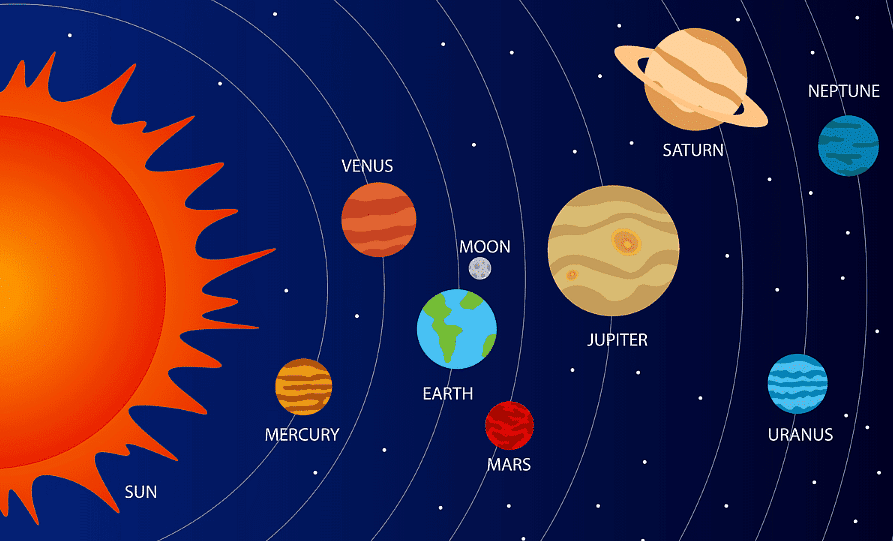 Our Solar System
Our Solar System
Interesting Fact:
For thousands of years humans believed that the Earth was at the centre of the universe. Astronomers such as Copernicus, Galileo Galilei and Isaac Newton discovered the movement of the planets and explained that the Sun’s position at the centre of the solar system.
The Planets
Mercury, Venus, Earth and Mars are closer to the Sun. They are called the inner planets (Terrestrial planet). They are formed of rocks and iron. Only the Earth has water on it.
Jupiter, Saturn, Uranus and Neptune are further away from the Sun and are called the outer planets. They are very cold and contain frozen gases.
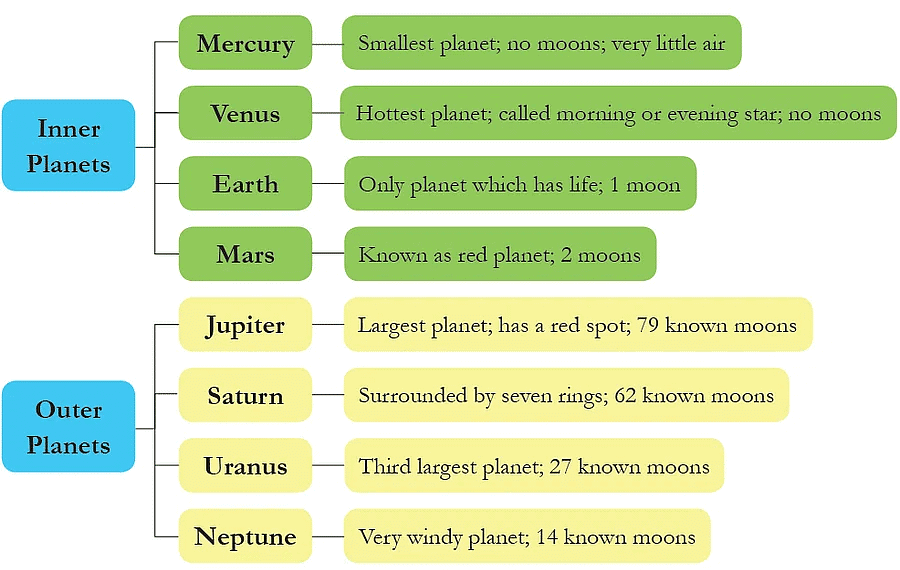
- Mercury, the smallest planet is nearest to the Sun. It is very hot during the day and very cold at night. There is very little air around Mercury. It has no moons.

- Venus is the hottest planet. It shines the brightest among all planets. It is often called the morning star or the evening star as it can be seen in the morning and evening. Venus also does not have any moon.
- Earth is the only planet that is known to have life. This is because the temperature is neither too hot nor too cold, it has water and is surrounded by air containing oxygen. It has one Moon.
- Mars is known as the red planet. It appears red because its surface is covered with red dust. It has 2 moons.
- Jupiter is the largest. Jupiter has a large red spot on its surface. Scientists say that the spot is actually a storm which has been blowing on the surface of Jupiter for years! It has 95 known moons.

- Saturn, the second largest planet has seven wide rings that surround it. These rings are made of ice and dust. It has 146 known moons.
- Uranus is the third largest planet. It has 28 known moons.
- Neptune is a very windy planet. Strong winds with speeds of 2000 kilometres an hour blow across the planet. It has 16 known moons. All these planets move around the Sun in a fixed path.
EduRev Tips:
Trick to remember names of planets in sequence::
Movements of the Earth
The Earth moves in two main ways.
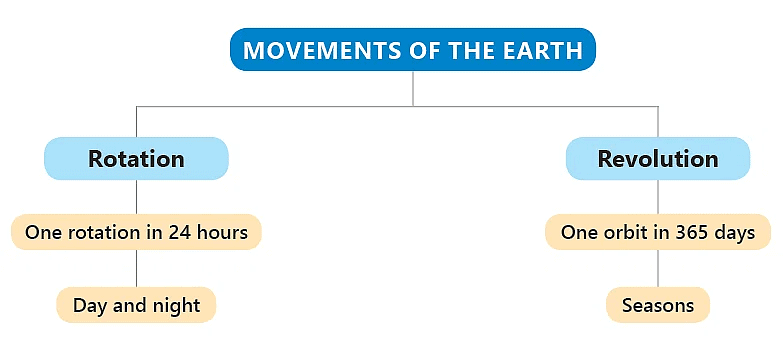
- Revolution: It travels in a fixed path around the Sun. This fixed path is called an orbit. The Earth revolves around the Sun in its orbit. It is called revolution. It takes about 365 days, or one year, to complete one revolution.
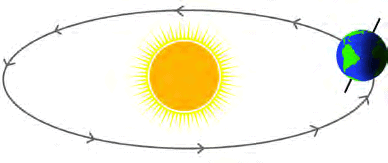 Revolution of Earth
Revolution of Earth
- Rotation: Besides revolving, the Earth also spins like a top. This movement is called rotation. The Earth completes one rotation in about 24 hours.
If you pierce a knitting needle through the centre of a ball, you can rotate the ball around the needle. The needle is then the axis around which the ball rotates. Even if you remove the needle, the ball can still be rotated around the same axis.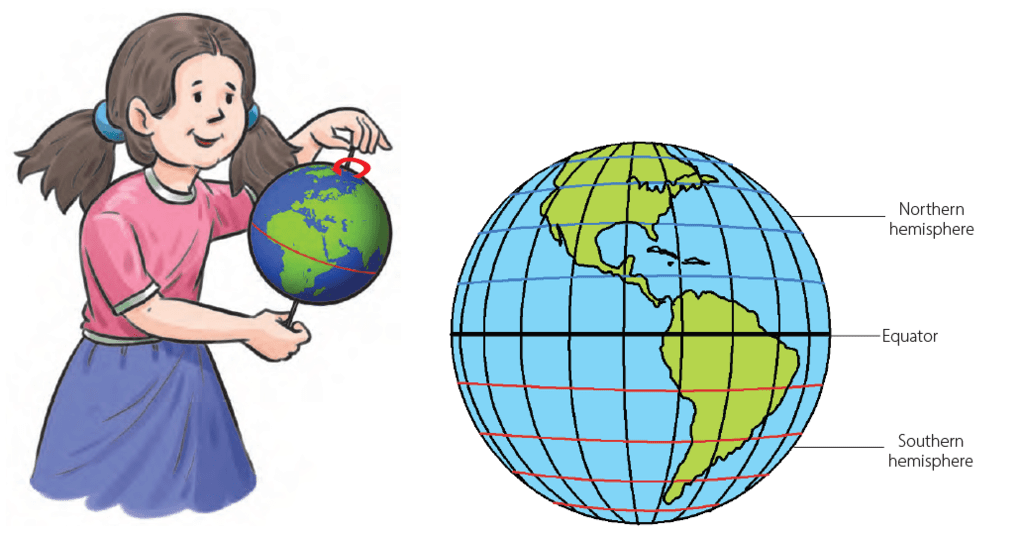
Similarly, the Earth rotates around an axis passing through its centre, from the north pole to the south pole. Of course, there is no knitting needle going through the Earth! Its axis is an imaginary line.
There is another imaginary line going around the Earth. It is called the equator. It divides the Earth into two halves, called the northern hemisphere and the southern hemisphere.
Effects of the Earth’s Movements
(a) Day and Night
- The rotation of the Earth causes day and night.
- Only one half of the Earth, which is facing the Sun is lit at one time. The other half which is away from the Sun is in darkness.
- As the Earth rotates, different places move in and out of sunlight. This causes day and night.
- When it is day-time on one side of the Earth, it is night-time on the other side. As America is on the opposite side of India, when it is day in India, in America it is night. Therefore, different areas on Earth will have a different time at any moment.
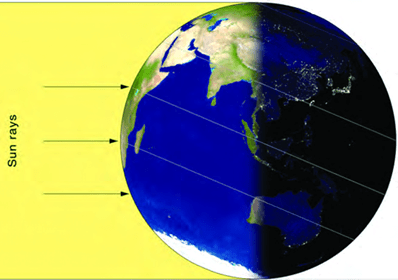 Rotation causes day and night
Rotation causes day and night
(b) The Seasons
You know that it is warmer in summer than in winter. Days are longer in summer than in winter. This happens because of the revolution of the Earth around the Sun. Let us see why this happens.
- While revolving around the Sun, the Earth is tilted to one side. We say that it is tilted on its axis. You can see clearly that when the north pole N is tilted towards the Sun, the south pole S is tilted away from the Sun. And when the south pole S is tilted towards the Sun, the north pole N is tilted away from it.
- The half of the Earth that tilts towards the Sun gets longer hours of sunshine and has summer. The half that tilts away from the Sun has lesser hours of sunshine and has winter.
- When the northern hemisphere has summer, the southern hemisphere has winter. And when the northern hemisphere has winter, the southern hemisphere has summer. So when it is summer in India, it is winter in Australia.
(c) The Poles
- Due to the tilted axis of the Earth when it is summer in the northern hemisphere, the north pole is tilted towards the Sun. It then has sunshine all the time, even as the Earth rotates.
- At that time, it is winter in the southern hemisphere. The south pole has night all the time.
- The poles have sunshine for six months in a year and night for another six months.

(d) The Equator
- Places near the equator receive long hours of sunlight throughout the year, even in winters. That is why they are always hot. There is no winter season in these places.
- Places far away from the equator experience more marked difference between summer and winter. That is why there is such a difference between Delhi (far away from the equator) and Chennai (nearer the equator).
Important Fact:
In India, we celebrate a lot of festivals to mark the change of seasons and harvesting of crops. Basant Panchami, Holi, the Myoko festival of Arunachal Pradesh and the Goa carnival are all celebrated to mark the arrival of spring. Baisakhi is celebrated in north India in April. Lohri is a popular Punjabi festival meant to be celebrated on the shortest day of the year. The Jaisalmer desert festival is celebrated in winter. Pongal and Makar Sankranti are celebrated on January 14, when people worship the Sun God.
|
52 videos|70 docs|53 tests
|
FAQs on The Solar System Class 4 Notes Science
| 1. What is the definition of a solar system? |  |
| 2. How many planets are in our solar system and what are their names? |  |
| 3. What causes day and night on Earth? |  |
| 4. How do the Earth's movements affect the seasons? |  |
| 5. What is the significance of the equator and the poles in relation to Earth's movements? |  |

